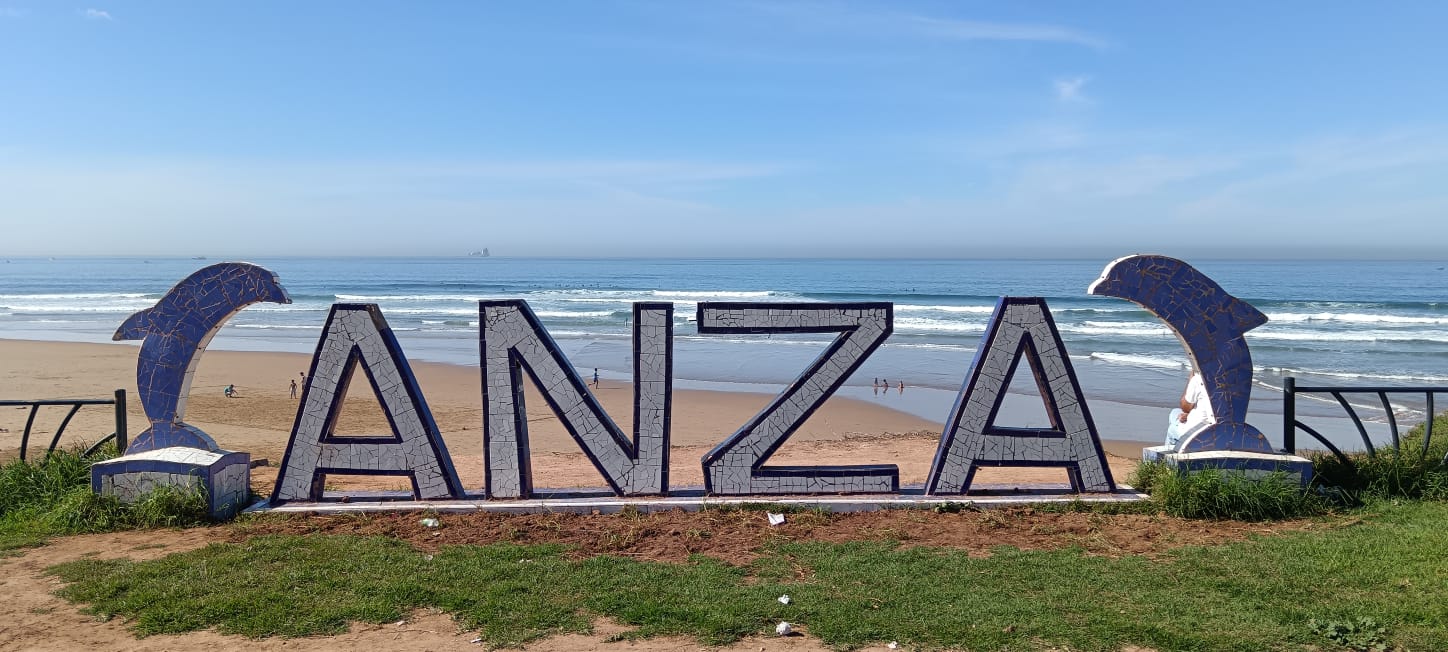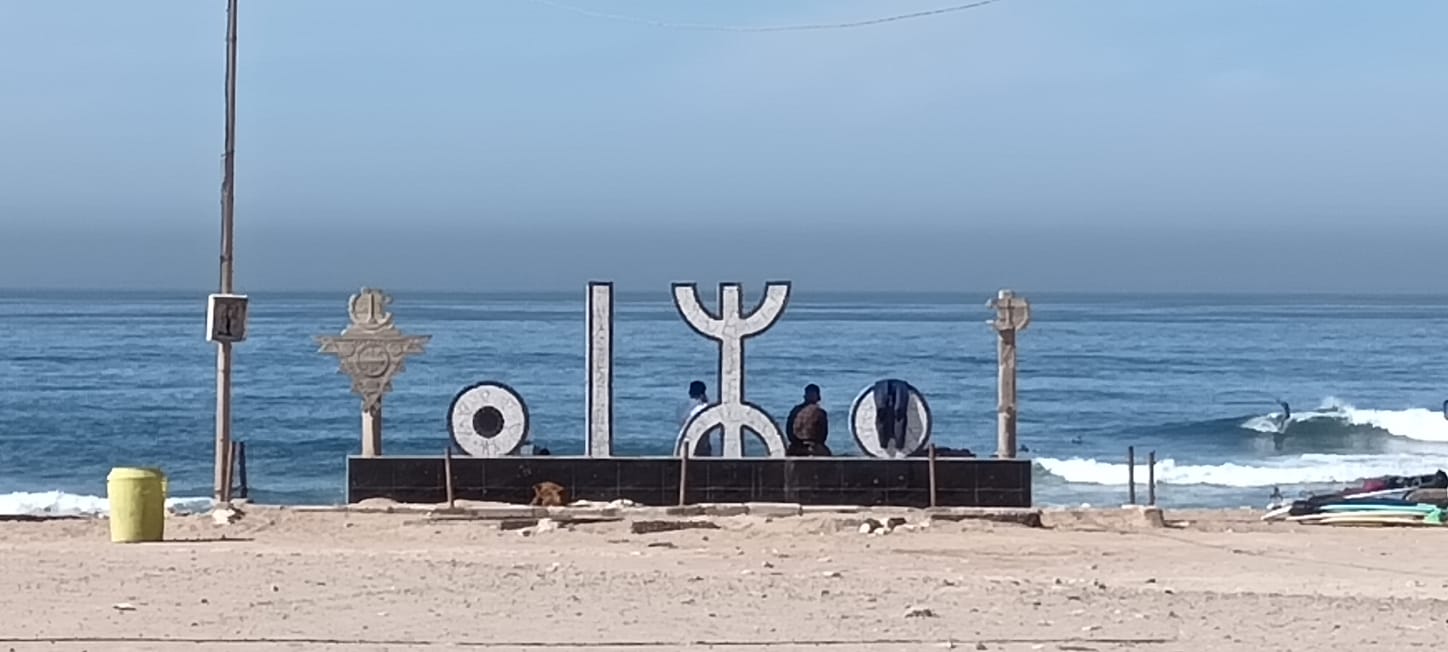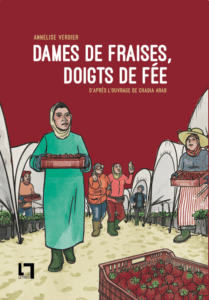From « Anza al-khanza » to a Touristic Destination Thanks to Locals and Youth’s Efforts
In the north of Agadir, nestled between two of the most beautiful and touristic places in Morocco, Agadir’s Marina (12 km by road) and Taghazout (16,4 km), Anza struggles to overcome the tough reputation of an industrial pollution.
In a café on Hassan Ist Street, in the city of Agadir, I had the chance to meet Karim[1] a 28-year-old high school French teacher. Karim, who grew up in the Taddart Anza neighborhood, shared his experiences, as I inquired about life in Anza. His narrative was filled with a palpable sense of pain and distress as he described the situation in Anza.
A childhood surrounded by pollution
During our conversation, Karim shared his memories of growing up in Taddart Anza: « As for my childhood years, we used to live in Taddart Anza. During those days, the main roads hadn’t reached our area yet. That’s what comes to mind when I recall those days. I would often go down to the beach in Anza, which was not away from my house. Despite our proximity to the sea, it was treated more as a curse than a blessing. You couldn’t swim in it freely as you wished due to water pollution. We heard many stories of people who swam there and ended up with skin rashes, and the scent of the sand was far from pleasant. This is what I remember from my childhood, along with the unpleasant odors emanating from the factories in the area.«
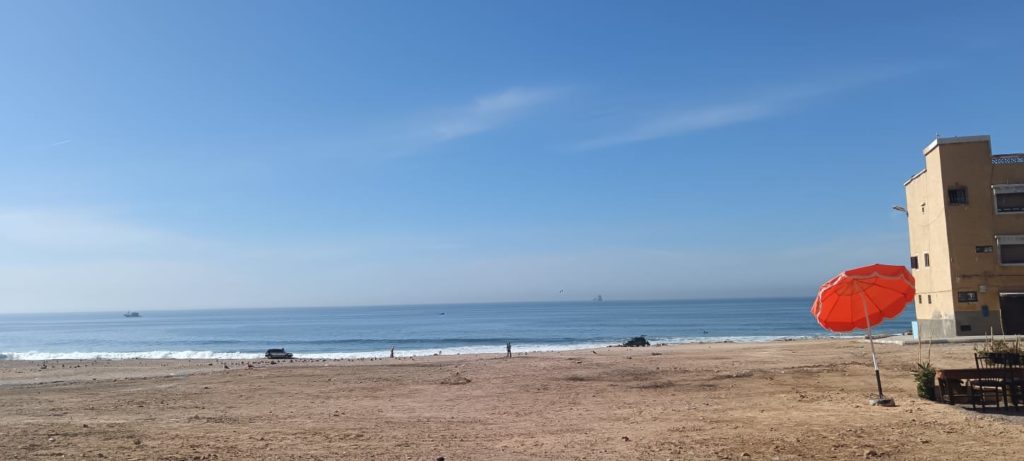
Karim went on to say: « Taddart is situated atop a hill, which made us somewhat far from the factory odors and pollution problems that plagued the beach. While the local residents were grappling with these challenges, we were fortunate to be in a relatively safe distance from these problems. »
He continued, with sadness in his eyes: « In Taddart, there was a system known as « clandestine transportation », which was simply referred to as « hitching a ride ». I particularly remember the time when I was preparing for my baccalaureate exams, and I had to rely on buses for my daily commute. It was a challenging period with the buses, and this is what we went through, and I still see the scarcity of buses in the area.«
Karim went on to describe, and I noticed the anguish in his eyes as he recounted those days: « Sometimes, when I waited at the bus station near my home in the morning around 8 o’clock, the bus would arrive packed with passengers and pass by without stopping to pick us up. So, I had to trek to the station further away from home, which required a considerable walk. Once we managed to get inside the bus, we had to endure extreme crowding. The buses were so crowded that finding breathing space was a challenge in itself. At times, we even had to share the bus with laborers who worked in the ports, wearing their work clothes and emanating an unpleasant odor. They too had to squeeze in with the rest of us on the bus. »
His fingers caress the cup of coffee, reflecting his stress, as he continues: « The transportation problem was indeed complex. At one point, there was an attempt to launch private buses exclusively for high school students. However, this experiment was an absolute failure. They didn’t provide transportation directly to our high schools; instead, the buses would only take us to the Anza area near the roundabout. This meant that we had to walk long distances to reach our high school.«
He sighed heavily and continued: « Even though a second bus might come later, the time you’d spend waiting for that bus would be enough for you to walk to school on foot. » He added: « In the Taddart neighborhood, there were several primary and middle schools, but unfortunately, there was no high school in the area. So I had to make the move to the Anza area to continue my education. »
Anxiously, Karim speaks the truth, and I was following him, observing how much he was worried and sad. He continued: »The people in the Anza neighbourhood were significantly affected by the pollution problem, sometimes even unknowingly. Reports of increased respiratory-related illnesses among the local population were heard. As for the visible aspects, the odors were evident and bothersome. While waiting for the bus, there was an unbearable stench, which forced us to cover our noses with whatever we could find to endure the wait.«
He went on, using expressive gestures and his hands to vividly describe the area, and I listened closely, overwhelmed by empathy for the countless students who had faced similar difficulties: « The road we walked from the roundabout to the school passed by the cement factory, where unbearable dust was emitted. This road was lined with cement piles, making the situation catastrophic. Even when we descended to the beach, we could see the factory’s remnants. These visible aspects of the pollution problem were clear and disconcerting for everyone. » He stated: « Since childhood, we had heard warnings about the effects of pollution on people who swam at this beach. As a result, we refrained from swimming there during that time. » As he spoke, I couldn’t help but imagine what it must have been like living next to the beach but unable to swim there.
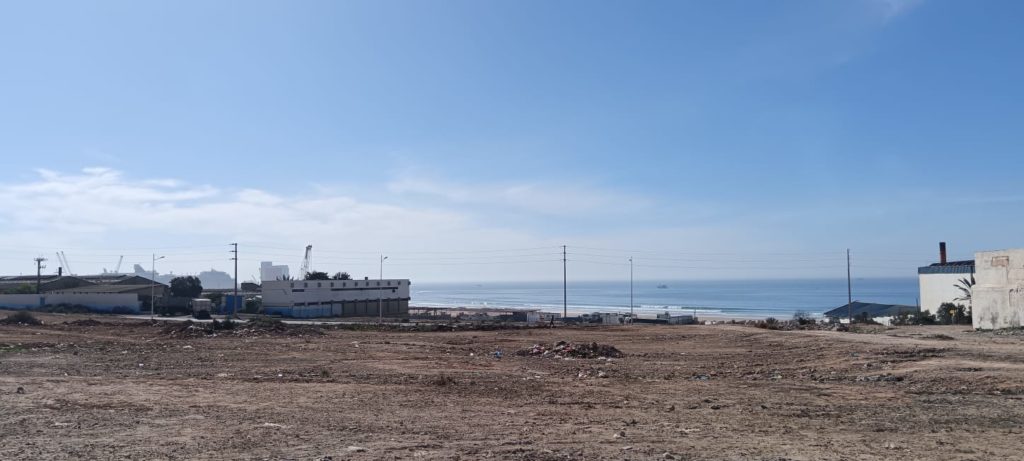
In a heartfelt conversation, he revealed: « I faced a lot of bullying during my time in Anza. When you think of Anza, the phrase « Anza alkhanza » automatically comes to mind. This is because the smell in that area was indeed extremely unpleasant and hard to endure, and you had to constantly shield your nose when you were there.«
He added: « I also recall that the odor situation persisted even during my university years. Despite the efforts and interventions by associations and reports published about what these factories were doing, there was no radical solution to eliminate this problem. Although pollutant emissions have decreased in recent times, the effects still linger.«
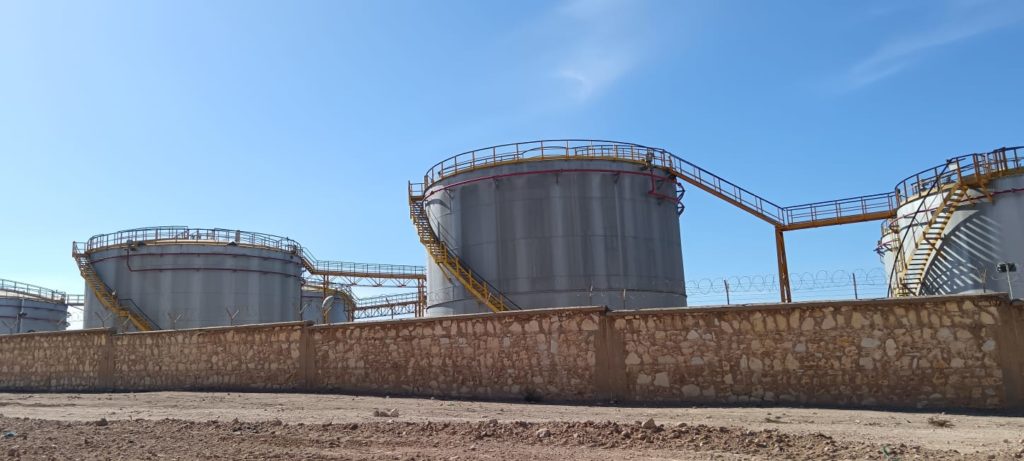
He candidly stated: « Recently, I sat in a café in Anza and were taken aback by an extremely unbearable foul odor, which forced us to leave the place. This indicates that the problem still persists to this day. Additionally, there is a video revealing illegal activities, where toxic substances and liquids are being discharged near tourist areas.«
The conversation with Karim inspired me to revisit Anza, to witness the current state of the area and determine if any changes had occurred. Embarking on the road to Anza presents its challenges. My journey began at the Abattoirs, the anticipated starting point of my expedition. A spot where various people from different backgrounds come together. You’ll find people rushing to catch taxis and waiting for buses, which makes it always crowded. This place is filled with markets, small restaurants, and street vendors selling various items, from food to clothing like pyjamas and shoes. Amidst the hustle and bustle, you may also notice homeless individuals and occasionally some who have had a bit too much to drink, sometimes even children.
The initial plan was simple: to board the Grand Taxi that typically shuttles passengers to their destinations in Anza. However, my optimism began to wane upon my arrival at the Abattoirs. Despite my expectations, a staggering 40-minute wait yielded no appearance of the awaited taxi. There was only one, but people rushed to it. The journey that normally takes approximately 15 minutes took 40 minutes just waiting. This unforeseen delay led me to make an alternative choice — to undertake the journey by car, accompanied by a friend. The challenge here isn’t just the lack of taxis, but also due to the fact that during summer, the road is full of cars all heading towards Taghazout. This explains why taxi drivers avoid going to Anza city, to escape this crowded place.
I was expecting the familiar bad smell to welcome me again, just as it had done before. I anticipated Anza to greet me with its characteristic phrase: « Welcome to Anza alkhanza, » as people call it. However, upon my arrival, I didn’t detect any odor. It’s possible that I couldn’t smell anything due to being sick. A beautiful view welcomed us, and the sign « Anza » in Tifinagh characters seemed to open its heart to us.
To be honest, numerous questions flooded my mind as I journeyed to Anza. I couldn’t help but wonder how such a beautiful spot and location could be overlooked. I pondered how the residents manage to live there amidst such challenging circumstances: living there and smelling the bad smell, with some of them even falling ill. How do they maintain their patience in the face of pollution and unpleasant odors in the air? How have they adapted to these conditions, even managing to breathe comfortably? My mind was filled with many other questions as well.
The difficult struggle for rehabilitation
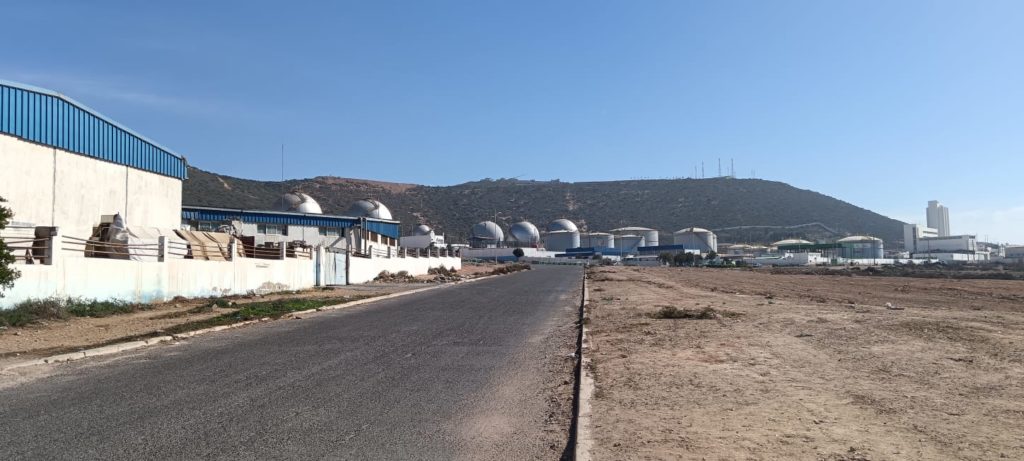
I met Mustapha Habach, a young activist and a member of the ‘Daynasour’ association, which aims to protect the natural heritage. Its goal is to preserve environmental aspects, including dinosaur traces, caves, paintings, and seas. The association was established in 2020. Mustapha has been actively advocating for the development of Anza city. He introduced me to the ‘Blue Waves’ association, founded in 2013, with the goal of surfing and preserving the coastal environment. Afterward, we found a comfortable spot in a beachfront cafe, enjoying a picturesque view. Engaging in a friendly conversation, we delved into the situation in Anza and the dedicated efforts carried out by the activists and associations.
Mustapha spoke with a palpable sense of pain in his heart about the situation in Anza. His enthusiasm and energy were evident as he passionately discussed the issues at hand. He began by addressing the plight of those who had fallen ill due to the pollutants that contaminate the air, such as silicosis caused by cement and various respiratory and constrictive diseases due to laboratories emitting fumes without adhering to national standards. Most of those affected are workers. In response, I promptly expressed my interest in interviewing someone who had experienced this firsthand. Regrettably, Mustapha informed me that individuals were hesitant to speak to me as a journalist due to fear of potential repercussions, which prevented them from sharing their experiences candidly. However, he emphasized that the situation was terrible, to the extent that people were losing their lives due to these conditions.
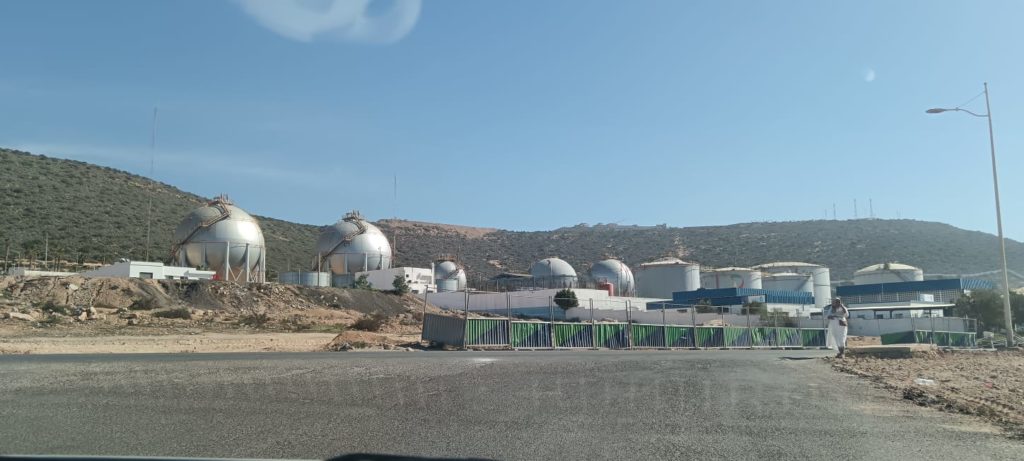
He mentioned that if you were to ask older people in Agadir about Anza, they would definitely paint a disastrous picture of it. No one wanted to come and live here before. He added: « The aspect that intersects with security and politics is the realm of illnesses. People are hesitant to disclose their diseases, and the authorities, too, are reserved due to the legal implications that involve compensation for harm. Speaking as a native of the region, I can attest that the area has suffered significant setbacks with limited progress, with the exception of the beach, which is a royal project. » He points out the Agadir Urban Development Program (2020-2024) from which the city of Agadir benefited. These projects included the rehabilitation of infrastructure, the road network, and lighting, as well as initiatives to preserve the environment and create and rehabilitate green spaces, parks, and public squares.
He continues: « Amid the challenges and threats I faced, my determination to stand up for Anza remained unshaken. Despite Anza bearing the brunt of pollution for a considerable period, a remarkable transformation has unfolded. It has evolved from an area heavily impacted by environmental degradation into a thriving tourist destination.«
He added: ‘‘The youth of the region were the ones who created the blue waves, characterized by their interest in the sea, and they began to fight against sea pollution. They decorated the sides of the sea in a way that preserves the environment. They created the name Anza in Tamazight and French. They made an entrance to dinosaur traces, which led to a group of scholarships coming from various countries, including doctoral and master’s degrees, and educational scholarships, to discover this natural heritage. This change made the press shed a lot of light, and they came to film documentaries and reportages, such as what was done by the Reuters Agency, which filmed a reportage that was published in various countries around the world on the footprint of dinosaurs. This media radiation, in addition to the great role of youth in social media, prompted people to pay attention to Anza. As a civil society, we demanded our rights from royal projects, and we actually benefited from them. We are very happy. The initial skepticism surrounding this transformation has given way to the undeniable reality of today.’’
He emphasizes that the term « Anza alkhanza » has become “deeply intertwined with our identity, with even the authorities contributing to its perpetuation”. With a tenge of sadness, Mustafa shared, « acknowledging the reality of pollution, there’s also a psychological toll that accompanies it. » He went on: « During my university days, I carried the burden of being perceived differently. Even when entering the French institute, I found myself under a more watchful eye compared to other youth from Agadir. Yet, a shift has taken place, and things changed.’’
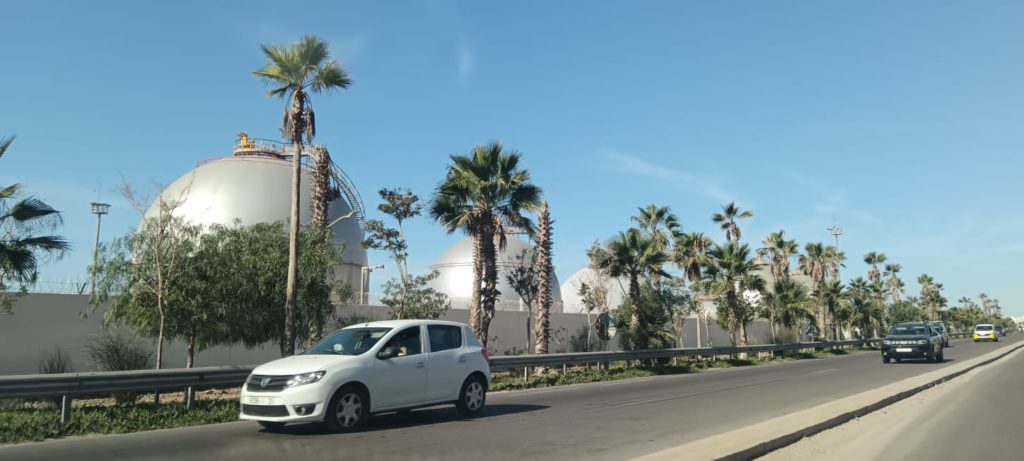
He also delved into the subject of gas within the locality, shedding light on the presence of multiple warehouses designated for the storage of both liquid and gaseous fuels. Memories of our childhood resurfaced; I remembered the fear we experienced, knowing that at any given moment, life could be shattered by an explosion. I distinctly recall the unease that enveloped us as we journeyed from Anza to Taghazout during my childhood.
Mustapha pointed out the gas release and said: « Sometimes they release the gas to prevent problems, as there’s a high risk of an explosion. In the scorching Agadir heat, a big concern arises. When it’s hot, the gas expands. If they don’t release some of it, it could explode. But releasing it makes the air hard to breathe, like choking. The tricky thing is, the gas doesn’t go away easily; it sticks to your lungs, dangerous in its own way. »
When I asked about the workers there getting sick, he joked: « Look at me, see how pale I am? I’m sick! » And he laughed. « We’re used to it now« , he added with a hint of nostalgia. « I still swim here because it’s where I was born, where I grew up by the port. »
As we converse, I notice a sense of pride in his eyes, a pride tied to his connection with the Anza region. As someone born in Agadir, I often feel a sense of sorrow for the challenges that surround me. Even Agadir’s once-proud beach has been affected; regrettably, it’s not safe for swimming anymore. Since 2017, we haven’t received the Blue Flag designation, bestowed by the Mohammed VI Foundation for the Protection of the Environment, along with the International Foundation for Environmental Education.
People in Agadir now like to visit cafes in Anza and enjoy the beautiful view there. Despite these challenges and the reputation of ‘Anza Alkhanza,’ the dedication of the youth, the locals, and the activists has turned Anza into a desirable tourist destination.
Malika Akestour
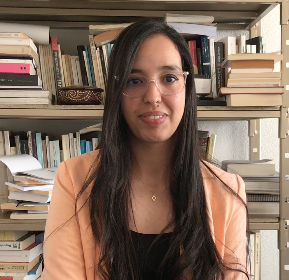 | Malika Akestour est doctorante. Sa thèse porte sur les médias et la politique, en particulier sur l’impact des médias sociaux sur le comportement électoral. Journaliste indépendante, elle travaille dans l’équipe arabe du Centre international des journalistes basé à Washington (International Center for Journalists, IJNET). |
| Ce reportage a été réalisé dans le cadre de la session Openchabab Environnement, avec le soutien de la Fondation Heinrich Böll. |  |
[1] The first name has been modified.

